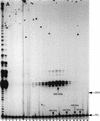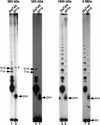Developmentally programmed assembly of higher order telomerase complexes with distinct biochemical and structural properties
- PMID: 9744868
- PMCID: PMC317169
- DOI: 10.1101/gad.12.18.2921
Developmentally programmed assembly of higher order telomerase complexes with distinct biochemical and structural properties
Abstract
In Euplotes crassus, telomerase is responsible for telomere maintenance during vegetative growth and de novo telomere synthesis during macronuclear development. Here we show that telomerase in the vegetative stage of the life cycle exists as a 280-kD complex that can add telomeric repeats only onto telomeric DNA primers. Following the initiation of macronuclear development, telomerase assembles into larger complexes of 550 kD, 1600 kD, and 5 MD. In the 1600-kDa and 5-MDa complexes, telomerase is more processive than in the two smaller complexes and can add telomeres de novo onto nontelomeric 3' ends. Assembly of higher order telomerase complexes is accompanied by an extended region of RNase V1 and RNase T1 protection in the telomerase RNA subunit that is not observed with telomerase from vegetatively growing cells. The protected residues encompass a highly conserved region previously proposed to serve as a platform for formation of higher order structures. These findings provide the first direct demonstration of developmentally regulated higher order telomerase complexes with unique biochemical and structural properties.
Figures









Similar articles
-
Interactions between telomerase and primase physically link the telomere and chromosome replication machinery.Mol Cell Biol. 2002 Aug;22(16):5859-68. doi: 10.1128/MCB.22.16.5859-5868.2002. Mol Cell Biol. 2002. PMID: 12138196 Free PMC article.
-
Developmentally regulated initiation of DNA synthesis by telomerase: evidence for factor-assisted de novo telomere formation.EMBO J. 1997 May 1;16(9):2507-18. doi: 10.1093/emboj/16.9.2507. EMBO J. 1997. PMID: 9171363 Free PMC article.
-
Reiterative dG addition by Euplotes crassus telomerase during extension of non-telomeric DNA.Nucleic Acids Res. 1998 Sep 1;26(17):3998-4004. doi: 10.1093/nar/26.17.3998. Nucleic Acids Res. 1998. PMID: 9705511 Free PMC article.
-
Telomerase and the chromosome end replication problem.Ciba Found Symp. 1997;211:20-8; discussion 28-34. doi: 10.1002/9780470515433.ch3. Ciba Found Symp. 1997. PMID: 9524749 Review.
-
Fingering the ends: how to make new telomeres.Cell. 2003 May 30;113(5):552-4. doi: 10.1016/s0092-8674(03)00397-0. Cell. 2003. PMID: 12787493 Review.
Cited by
-
Nucleolar protein PinX1p regulates telomerase by sequestering its protein catalytic subunit in an inactive complex lacking telomerase RNA.Genes Dev. 2004 Feb 15;18(4):387-96. doi: 10.1101/gad.1171804. Epub 2004 Feb 20. Genes Dev. 2004. PMID: 14977919 Free PMC article.
-
The solution structure of an essential stem-loop of human telomerase RNA.Nucleic Acids Res. 2003 May 15;31(10):2614-21. doi: 10.1093/nar/gkg351. Nucleic Acids Res. 2003. PMID: 12736311 Free PMC article.
-
Roles of telomerase reverse transcriptase N-terminal domain in assembly and activity of Tetrahymena telomerase holoenzyme.J Biol Chem. 2012 Apr 13;287(16):12805-14. doi: 10.1074/jbc.M112.339853. Epub 2012 Feb 24. J Biol Chem. 2012. PMID: 22367200 Free PMC article.
-
Ribonucleoprotein multimers and their functions.Crit Rev Biochem Mol Biol. 2010 Oct;45(5):331-50. doi: 10.3109/10409238.2010.496772. Crit Rev Biochem Mol Biol. 2010. PMID: 20572804 Free PMC article. Review.
-
Interactions between telomerase and primase physically link the telomere and chromosome replication machinery.Mol Cell Biol. 2002 Aug;22(16):5859-68. doi: 10.1128/MCB.22.16.5859-5868.2002. Mol Cell Biol. 2002. PMID: 12138196 Free PMC article.
References
-
- Beattie TL, Zhou W, Robinson MO, Harrington L. Reconstitution of human telomerase activity in vitro. Curr Biol. 1998;8:177–180. - PubMed
-
- Blasco MA, Funk W, Villeponteau B, Greider CW. Functional characterization and developmental regulation of mouse telomerase RNA. Science. 1995;269:1267–1270. - PubMed
Publication types
MeSH terms
Substances
Grants and funding
LinkOut - more resources
Full Text Sources
